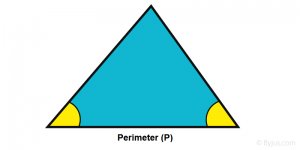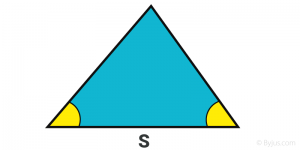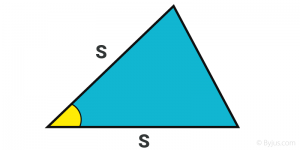onstruction Related to Line Segments
You must have seen many times that a point divides a line segment in a particular ratio. In this module, we will learn how to divide a given line segment in the desired ratio x:y without using a ruler.
Dividing a given line segment in a particular ratio
Let’s say we have been given a line segment AB which we want to divide it by a ratio of 3:2. Here, x = 3 and y = 2. To construct such a line segment, follow the steps as given below:
Steps of Construction
- Draw any ray AZ making an acute angle with AB.
- Locate 5 points (x + y = 3 + 2 = 5), say, A1, A2, A3, A4, and A5 using a compass on AZ such that these points are equally distanced from each other.
- Open the compass of a specific width and make an arc on the ray AZ keeping the needle on the point A. The point where the arc intersects with AZ is now A1. Repeat the step keeping the same width from A1 making a point A2. Repeat the steps 3 more times making AA1 = A1A2 = A2A3 = A3A4 = A4A5.
- Join A5 with B making a line segment A5B. (See Figure 1)
- Since we need to divide the line segment in 3:2, draw a line through the point A3 which is parallel to A5B by making ∠AA3C = ∠AA5B such that A3C intersects AB at the point C.
- To construct a parallel line using Angle Copy Method, adjust the width of the compass to roughly half of the length of A4A5. Keeping the needle at point A5, make an arc cutting the ray AZ and the line segment A5B. This is arc 1.
- Make a similar arc from point A3 using the same compass width. This is arc 2.
- Now, adjust the compass width to the arc 1 such that keeping the needle on the point where arc 1 intersects AZ, the pencil should be on the point where arc 1 meets the line segment A5B.
- Keeping the same width, cut the arc 2 making an intersecting point G.
- Make a line segment from A3 through G meeting the line segment AB at C. The line segment A3C || A5B.
- Therefore, AC : CB = 3 : 2. (See Figure 1)

Figure 1: AC : CB = 3 : 2
Rationale and Proof
Since A3C || A5B
∴
∴
Alternate Method
Following is the alternative method to divide a given line segment AB into a said ratio (same as above, that is, 3:2).
Steps of Construction
- Draw any ray AG making an acute angle with AB.
- Draw a ray BH parallel to AG by making ∠ABH equal to ∠BAG using the same method as described above in steps from 4(a) to 4(e).
- Locate the pointsA1, A2, and A3 (x = 3) on AG and B1, B2 (y = 2) on BH such that AA1 = A1A2 = A2A3 = BB1 = B1B2 using the same step as described in 2(a) above.
- Join A3B2. Let it intersect AB at a point C (See Figure 2).
- Then AC : CB = 3 : 2

Figure 2: AC : CB = 3 : 2 (Alternate method)
Rationale and Proof
Here,
∠CAA3 = ∠CBB2 [By construction]
∠ACA3 = ∠BCB2 [Vertically opposite angles are always equal]
∠AA3C = ∠BB2C [Alternate interior angles within two parallel lines are always equal]
∴ ∆ACA3 ~ ∆BCB2 [By AAA criteria of triangle similarity]
⇒
Now, using construction
∴
Construction Related to Triangles
We have studied about similar triangles and their properties in previous classes. Have you ever wondered how these similar triangles are designed? Let’s take a look how.
Constructing a triangle similar to a given triangle
There are a few ways by which we can draw a triangle similar to the given one. Here, we shall study how to construct the same using the Scale Factor method without the help of a ruler.
Scale Factor is the ratio of two corresponding sides of the similar triangles. For example, let’s say that ∆ABC is similar to ∆DEF (∆ABC ~ ∆DEF) wherein AB = 3, BC = 4, and AC = 5; whereas DE = 6, EF = 8 and DF = 10. Here, the Scale Factor of two corresponding sides is
So, let’s see how we can construct a triangle similar to the given triangle (∆PQR) with a scale factor of
Steps of Construction using Scale Factor
- Draw any ray QX making an acute angle with QR on the side opposite to the vertex P.
- Locate 4 points Q1, Q2, Q3, and Q4 on QX so that QQ1 = Q1Q2= Q2Q3 = Q3Q4 using the same method as described above in step 2(a) (Dividing a line segment in a given ratio). Note: We located 4 points because 4 is the greater value in the Scale Factor ratio of
34 - Considering the given triangle, ∆PQR, join a line Q4R.
- Draw a line through Q3 parallel to Q4R using the same method as described above in steps from 4(a) to 4(e) (Dividing a line segment in a given ratio) intersecting the line QR at R′. This gives us Q3R′ || Q4R and ∠QQ3R′ = ∠QQ4R (See Figure 3).
- Similarly, draw a line through R′ parallel to the line PR intersecting the line PQ at a point, P′. This gives us P′R′ || PR and ∠P′R′Q = ∠PRQ (See Figure 3).
- Subsequently, ∆P′QR′ is the required triangle similar to ∆PQR with Scale Factor of
34 .

Figure 3: ∆ P′QR′ ~ ∆PQR
Rationale and Proof
Since Q3R′ || Q4R and QQ3 is proportionate to QQ4 in the ratio of 3:4 (by construction)
∴
Here,
∠P′QR′ = ∠PQR [Common angle]
∠P′R′Q = ∠PRQ [By Construction]
∠R′P′Q = ∠RPQ [If two corresponding angles of two triangles are equal, the third angle will always be equal]
∴ ∆P′QR′ ~ ∆PQR [By AAA criteria of triangle similarity]
Since ∆P′QR′ ~ ∆PQR and
∴ ∆P′QR′ ~ ∆PQR with Scale Factor of
Solved Examples for You
Question 1: Given a line segment AB. Find a point, describing the steps, which divides the line segment in 2:1 without using a ruler.
Answer : Steps of Construction
- Draw any ray AX, making an acute angle with AB.
- Locate 3 points (x + y = 2 + 1 = 3), say, A1, A2, and A3 using a compass on AX such that these points are equally distanced from each other.
- Open the compass of a specific width and make an arc on the ray AX keeping the needle on the point A. The point where the arc intersects with AX is now A1. Repeat the step keeping the same width from A1 making a point A2. Repeat the step one more times making AA1 = A1A2 = A2A3.
- Join A3 with B making a line segment A3B. (See Figure A)
- Since we need to divide the line segment in 2:1, draw a line through the point A2 which is parallel to A3 by making ∠AA2B = ∠AA3B intersecting AB at the point C.
- To construct a parallel line, adjust the width of the compass to roughly half of the length of A2A3. Keeping the needle at point A3, make an arc cutting the ray AX and the line segment A3B. This is arc 1.
- Make a similar arc from point A2 using the same compass width. This is arc 2.
- Now, adjust the compass width to the arc 1 such that keeping the needle on the point where arc 1 intersects AX, the pencil should be on the point where arc 1 meets the line segment A3B.
- Keeping the same width, cut the arc 2 making an intersecting point O.
- Make a line segment from A2 through O meeting the line segment AB at C. The line segment A2C || A3B.
- This point C divides AB as AC : CB = 2 : 1. (See Figure A)

Figure A. AC : CB = 2 : 1
Question 2: What do you mean by segment in maths?
Answer: Segment refers to the part of a line that connects two points. It happens to the shortest distance that exists between the two points. Furthermore, segment has a length. The word “segment” is important because a line can go on continuously without end. In contrast, a line segment has definite endpoints.
Question 3: Explain what is meant by segments of circle?
Answer: A chord of a circle divides a circle into two parts. These parts are known as the segments of circle.
Question 4: How can one measure a line segment?
Answer: A line segment is nothing more than a part of a line. In order to measure the length of a line segment, put the segment’s endpoint on the ruler’s zero mark. They must see where it ends. In inches, one must round to the nearest ¼, while in centimeters; one must measure to the nearest centimeter.
Question 5: How can one find out the midpoint of a segment?
Answer: One can find out the midpoint of a segment by dividing the segment’s length by 2 and counting that value from any endpoint.
T
angents
A common tangent can be any line, a ray or a segment that can be a tangent to more than one circle at the same time. There can be one to four number of common tangents to two circles. The point to be noted is that a tangent of a circle touches the circle but never enters it. Also, multiple tangents to the two circles can be an outer tangent or an inner one to each other’s circles.

Figure 1: Circle with a centre O and tangent as PQ. X is the point of tangency
Note: There can only be two tangents drawn from one point outside the circle. In this module, we’ll learn the art of constructing two tangents to a given circle from a point outside the circle without the help of a scale.
Browse more Topics under Constructions
Constructing Tangent of a Circle
We can come across two cases while constructing tangent of a circle. These are described as follows:
Case I: When the centre of a circle is known
Let’s say that we are given a circle with centre O and a point P outside it, and we have to construct two tangents from the point P to the circle without the help of a ruler. Follow the steps of construction as below:
- Join OP and bisect it. To bisect OP, take a compass, and open it slightly more than half of the length of the line segment.
- From point P, mark a minimal arc above and below the line segment. Repeat the similar step from point O keeping the opening of the compass as same as it was from point P. Two points will be created where the two arcs, produced from point O and point P, meet.
- Joint these two points with a line segment using a scale. This line segment bisects the OP. Let’s consider H as the mid-point of PO.
- Taking the point H as a centre and HO as a radius, draw a circle. Let it intersect the given circle at the points, T and T’.
- Join PT and PT’. Then PT and PT’ are the required two tangents.

Figure 2: Drawing tangents PT and PT’ (marked in red) to the circle
Proof and Rationale
To check if the construction is correct:
- Join OT. Then ∠PTO is an angle in the semicircle and, therefore, ∠PTO = 90° [ angle in a semicircle is always 90°]
- Check with the 180° protractor ensuring that ∠PTO = 90°.
Since OT is the radius of the circle with centre O and ∠PTO = 90°, therefore, PT has to be a tangent to the circle. This is because of the property of the circle which states that the radius from the centre of the circle to the point of tangency is perpendicular to the tangent line. Similarly, PT’ also becomes a tangent to the circle.
Case II: When the centre of the given circle is not known
In that case:
- Draw any two non-parallel chords in the given circle
- Draw perpendicular bisectors to both of the chords (as described in steps 2 and 3 above in Case I) (See Figure 3)
- Find the point of intersection of two perpendicular bisectors which will be the centre of the given circle.
- Follow the same steps from 1 to 5 as described above in Case I.

Figure 3: Intersection of two perpendicular bisectors is the centre point O
Solved Examples for You
Question 1: Given a circle without a centre point and a point P outside the circle. Find the centre point of the circle and draw two tangents from the point P to the circle. Describe the steps.
Answer : Steps of Construction:-
- Draw any two non-parallel chords (CD and EF) in the given circle
- Draw perpendicular bisectors to both of the chords.
- To bisect CD, take a compass, and open it slightly more than half of the length of the line segment.
- From point D, mark a minimal arc above and below the line segment. Repeat the similar step from point C keeping the opening of the compass as same as it was from point D. Two points will be created where the two arcs, produced from point C and point D, meet.
- Joint these two points with a line segment using a protractor. This line segment bisects the CD.
- Repeat steps from 2 a to 2 c for drawing a perpendicular bisector for EF.
- Find the point of intersection of two perpendicular bisectors which will be the centre of the given circle, say point O. (See Figure A)
- Join the centre point O to the given point P outside the circle.
- Bisect OP by following steps from 2 a to 2 c. Taking the point G as a centre and OG as a radius, draw a circle. Let it intersect the given circle at the points, T and T’.
- Join PT and PT’. Then PT and PT’ are the required two tangents.
Question 2: What does it mean if a line is tangent to a circle?
Answer: A tangent line refers to a line that is intersecting a circle at one point. We call such a line the tangent to that circle. Moreover, the point at which the circle and the line intersect is referred to as the point of tangency. In other words, for any tangent line, there will be a perpendicular radius
Question 3: How many tangents can a circle have?
Answer: A circle has 0 tangents. We can draw exactly 0 tangents through a circle. A tangent will intersect a circle in only one point so that it does not enter the area of the circle. Moreover, we can draw an infinite number of tangents to a certain circle as there won’t be any limits to the points for a tangent to intersect.
Question 4: Is a tangent line perpendicular?
Answer: A tangent to a circle is a line that intersects the circle at precisely one point. It is the point of tangency or tangency point. A significant result is that the radius from the centre of the circle to the point of tangency will be perpendicular to the tangent line
Question 5: What does tangent mean?
Answer: In geometry, the tangent line or sometimes simply called the tangent, is a plane curve at a certain point is the straight line which “just touches” the curve at that point. Leibniz stated that it is the line through a pair of infinitely close points on the curve. Moreover, the word “tangent” is derived from the Latin ‘tangere’ which means ‘to touch’.

Figure A: Tangents PT and PT’ from the given point P outside the given circle (highlighted)









Post a Comment
Post a Comment